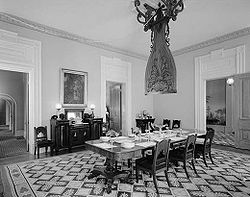
Punkah
Encyclopedia

Fan (implement)
A hand-held fan is an implement used to induce an airflow for the purpose of cooling or refreshing oneself. Any broad, flat surface waved back-and-forth will create a small airflow and therefore can be considered a rudimentary fan...
used in the early 500 B.C.. In its original sense the punkah was a portable fan made from the leaf of the palmyra
Borassus
Borassus is a genus of six species of fan palms, native to tropical regions of Africa, Asia and New Guinea. They are tall palms, capable of growing up to 30 m high. The leaves are long, fan-shaped, 2 to 3 m in length...
.
In the colonial age, the word came to be used in a special sense by Anglo-Indian
Anglo-Indian
Anglo-Indians are people who have mixed Indian and British ancestry, or people of British descent born or living in India, now mainly historical in the latter sense. British residents in India used the term "Eurasians" for people of mixed European and Indian descent...
s in British India for a large swinging fan, fixed to the ceiling, and pulled by a coolie
Coolie
Historically, a coolie was a manual labourer or slave from Asia, particularly China, India, and the Phillipines during the 19th century and early 20th century...
, called the punkawallah
Punkawallah
In India and Pakistan, a punkawallah is a manual fan operator.A punkah is an early type of ceiling fan used in the Indian subcontinent before the creation of the electric fan and the punkahwallah was the servant whose job it was to work it. It often used a pulley system....
, during the hot weather.
The date of this invention is not known, but it was familiar to the Arabs as early as the 8th century. The punkah was not commonly used in India before the end of the 18th century.
The electric fan largely supplanted it in barracks and other large buildings at the beginning of the 20th century.
The term was carried over to punkah louvre, to refer to the outlet for (cool) air in aircraft, particularly those over the passenger seats.

